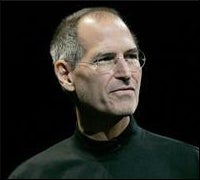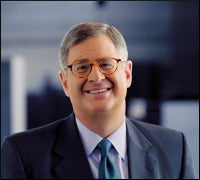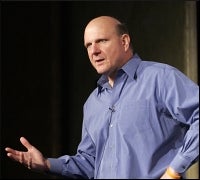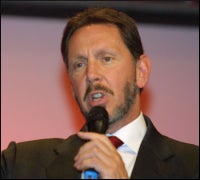Every company plans for an orderly transfer of power, but there are times when that transfer has to be done on a more urgent schedule.
Whether it’s Apple CEO Steve Jobs’ health scare, Oracle CEO Larry Ellison’s tendency for an adrenaline rush or Broadcom CEO Henry Nicholas being busted for allegedly selling drugs, the fear always seem to loom that a time might come when a chief executive leaves the company minus the good-bye party and an orderly transfer of power.
As a result, it seems logical that companies ought to have a well thought-out line of succession to minimize disruption if unexpectedly facing the loss of a leader.
What we’ve found, however, is that firms have varying degrees of preparedness, while others’ lines of successions might be unexpected.
When we first looked at the tech industry’s CEO line of succession in 2006, we saw companies in various states of preparedness. Since then, a few of those companies have changed leadership to great effect.
It is a matter of responsibility for every public company to have a line of succession planned in case of emergency. For the IT field, it’s particularly important because this is a rapidly changing market and always will be. A company can ill-afford to go six months or a year without a CEO. That’s an entire product generation or two. A company in a slower-moving industry might get away with it but no tech company could wait that long.
The IT industry plays by a slightly different set of rules, noted Charles King, principal analyst of Pund-IT.
“I can’t think of any other industry, except maybe film and music, where there are what you might call cults of personality around many of the executives,” he said.
It’s happened before, he noted, always in hot, growth industries. In the 1920s, when oil was big, John D. Rockefeller enjoyed the profile Steve Ballmer of Microsoft and John Chambers of Cisco enjoy today. These days, oil executives are more likely to be vilified. When steel was a booming industry, Andrew Carnegie was the rock star. Today, steel is boring.
So for now, the first generation of tech leaders enjoy near-movie-star levels of celebrity as well as tremendous importance to their business.
“But it does raise the question of what happens when someone checks out or leaves,” King said. “For a company that really depends on its CEO for its mojo, the question is really serious.”
The company with the most question marks swirling around it these days is Apple (NASDAQ: AAPL). There will always be concerns about Steve Jobs’s health, even if he lives another 30 years, due to his coming down with what could have been a deadly form of cancer. His recent gaunt appearance at the World Wide Developer Conference has only increased worries.
 |
Steve Jobs Source: Reuters |
Jobs and Apple are widely viewed as inexorably linked, so replacing him seems darn near impossible. Fortune magazine, noting all the chatter about Jobs’ condition, recently ran a speculative story on his potential successors.
No less than 11 executives came up, including COO Tim Cook and Jonathan Ive, the senior vice president of industrial design and head of Apple’s design team that gives all of its products such a stylish look.
While those two are considered the leading contenders, the truth is, no one knows, since determining who might succeed Jobs is made all the more difficult because the company operates in such secrecy.
 |
Jonathan Ive and Tim Cook Source: Apple |
“The consensus would be [that] Jobs certainly sets the tone and has the vision and sets the very high standards, which people under him have to meet,” Insight64 Research Fellow Nathan Brookwood told InternetNews.com. “Yeah, there are some good people in terms of the folks who are running the software and hardware groups, but they are kind of invisible to the outside world. And it’s not clear that any of them have that same magnetic, demanding, dictatorial nature that Jobs has demonstrated.”
But others thought there are people in place.
“It’s becoming clear that although Steve is still the visionary, that vision is part of an executive team vision,” Tim Bajarin of Creative Strategies said.
“They don’t have short-term visions,” Bajarin said, pointing to the fact that the iPhone was first kicked around in Apple back in 2002.
“They have visions the team puts together and test things that are more in 10-year cycles, not one year,” he said. “In that context, it seems clear to me that more and more of the team is involved in crafting the roadmap.”
Page 2: IBM, Intel and AMD
Page 2 of 4
That team includes Cook and Ive, whom the Times of London speculated could be Jobs’s heir, as did Fortune.
There’s also Bertrand Serlet, who heads OS development, and Phil Schiller, the marketing head. But if any of them is on tap to replace Jobs, Apple is, as usual, playing it close to its vest. The company declined to comment on this story.
Heirs apparent?
Most well-run companies have adopted a strategy that IBM is best known for using, moving its up-and-coming executives around across as many divisions as possible to give them the broadest exposure to the firm’s array of products.
That’s what’s at work in most of the firms on this list, as well.
However, many don’t talk publicly about their line of succession. If one person is identified as an heir too early, those not in line for the top spot may leave.
“Folks who tend to be in high-level executive positions are extremely ambitious,” King said. “If they’ve got their eye on a particular chair and it doesn’t look like it will be open in the near future, it’s not unlikely for them to look elsewhere.”
IBM
IBM (NYSE: IBM) set the standard for preparing executives for higher positions by moving them around the company so frequently. It’s because of this broad exposure to different areas of the business that IBM is frequently poached for executive talent. CA (NYSE: CA) even jokingly refers to itself as “IBM East.”
 |
Sam Palmisano Source: IBM |
As a result, there is a vast talent pool of executives who could replace Sam Palmisano. According to tradition, Palmisano is approaching the end of his career — IBM executives tend to retire in their early 60s.
So if Palmisano does plan to exit in the next five years, his heir already has to be on the internal radar. IBM spokespeople declined to say who that might be, however.
Ovum Vice President Tom Kucharvy felt Robert LeBlanc, the general manager of IBM’s global consulting services and head of its Service Oriented Architecture (SOA) initiatives, has a good chance. Previously, LeBlanc headed up the company’s Tivoli division.
“He’s being put in all the right spots,” Kucharvy said. “He’s been in the two biggest software groups and now a really important set of initiatives and in charge of IBM’s whole SOA strategy. The area he misses is systems.”
As it turns out, IBM Systems head Bill Zeitler announced his own retirement last month. But Bajarin thinks the top spot could go to Steven Mills, the head of IBM’s software division.
“He’s sharp. He knows the entire strategy, cross-company, and he’s risen through the ranks,” Bajarin said. “He would be one of the guys on my list because at that executive level, he understands the entire company.”
Intel
Across the country at Intel (NASDAQ: INTC), the line of succession may see almost clear — but not so fast. There are four executive vice presidents, a rank from where the CEO Paul Otellini’s likely successor will come.
 |
| Paul Otellini Source: Intel |
Sean Maloney, executive vice president and general manager of sales and marketing, is Brookwood’s choice.
At 51, Maloney is seven years younger than CEO Paul Otellini, who faces a mandatory retirement age of 65. However, Maloney isn’t the only executive with CEO potential.
“Behind them, you’ve got [Pat] Gelsinger, who has gained some credibility since switching to head of the digital enterprise group, and David Perlmutter, who heads up mobility,” Brookwood said. “The bottom line is Intel probably has the deepest bench.”
But John Spooner, senior analyst with Technology Business Review, thinks Andy Bryant, Intel’s longtime CFO, might make for a good leader.
“Bryant really understands the inner workings of the company,” he said. “Maloney is more similar to Otellini and Intel does need a sales guy, but at the end of the day, Intel is a manufacturing company and Andy Bryant really understands manufacturing.”
Spooner added that Perlmutter also has upward potential — and his big test is this year, with the launch of Nehalem.
Ultimately, the launch is Perlmutter’s responsibility. If Nehalem ships on time and is everything Intel promised, he can emerge a rock star.
But if Nehalem pulls a Barcelona, Perlmutter and AMD’s Hector Ruiz could wind up drinking buddies at a Silicon Valley watering hole, drowning their missed deadlines sorrows.
 |
Hector Ruiz Source: AMD |
AMD
On that note, when it came to who would succeed Hector Ruiz at AMD (NYSE: AMD), it was pretty unanimous: “Dirk Meyer is the man,” Brookwood said.
“Meyer is a lock,” added Spooner.
Even AMD acknowledged that Meyer, the company’s COO, is indeed the CEO-in-waiting. When Meyer ascends to the top spot, it’s felt that Randy Allen, longtime vice president and head of the server initiative, would move into Meyer’s current position.
Page 3: HP and Dell
Page 3 of 4
While AMD has lost some big names — notably its outspoken chief salesman Henri Richard and its respected CTO Phil Hester — new blood, particularly from IBM’s Austin processor business, have revitalized it.
 |
Mark Hurd Source: HP |
“They’ve brought in a lot of very good people from IBM and Motorola,” Brookwood said. “I don’t think you could characterize what’s gone on at AMD as a mass exodus. It’s more like an organizational evolution.”
HP
An HP spokesperson told InternetNews.com that upon his arrival, CEO Mark Hurd realized that HP (NYSE: HPQ) wasn’t moving its talent around as much as other tech firms and instituted the executive shuffle IBM and Intel use so effectively.
The result is a lot of mid-level executives are moving around within the company to get the breadth and scope of experience needed.
Still, of all the major tech firms, HP‘s succession seemed to evoke the greatest debate. Not that Hurd hasn’t done a tremendous job of righting the ship — of that, there’s little disagreement.
And among the industry watchers InternetNews.com spoke with, there was also unanimity in the belief that former CEO Carly Fiorina had a very good vision for the company, but failed in her ability to sell it.
The question is whether HP would promote internally or go for another CEO from outside the company, who would become its fourth outsider in a row.
Among the internal candidates, Ann Livermore, the longtime executive vice president of the company’s technology solutions group, is typically viewed as the leading candidate.
“The acquisition of EDS is doubling down on the enterprise business, so Ann is probably the favorite of anyone internally,” Kucharvy said. “I think Ann has sufficiently proven herself, particularly with some of the discipline being instilled in that organization.”
But Brookwood disagrees. “I don’t know if VJ [Vyomesh Joshi, executive vice president of the image and printing group division] or Ann would be up to it. I think Livermore has a good handle on the computer side of the house and VJ has a good handle on printing.”
“But I’m not sure there is anybody in the company who has a good handle on the combined enterprise, because they’ve been kind of compartmentalized,” he said.
 |
Vyomesh “VJ” Joshi and Ann Livermore. Source: HP |
While Livermore and VJ get the most attention, HP spokespeople noted that there are nine executives working within the company who have held the position of CEO elsewhere.
Those include former Palm CEO Todd Bradley, now executive vice president of HP’s personal systems group, and Thomas Hogan, senior vice president of the software division in HP’s technology solutions unit and former CEO of Vignette.
As a result, HP has a deep bench from which to draw as well.
Dell
When we first looked at the CEO line of succession in 2006, we said Michael Dell could always step back in to run the company he founded if he had to. Well, he did just that, taking over as CEO of Dell (NASDAQ: DELL) in February 2007.
And now it looks like he’s sticking around.
“I think Michael understands the next age of digital, and to be honest, I think he’s having fun again,” Bajarin said. “But they have an immense amount of talent.”
 |
Michael Dell Source: Dell |
A whole lot, Spooner noted. “Dell has a team of former CEOs or CEO-quality executives. I think just about everyone in senior management can take over as CEO of the company.”
“You’re looking at almost hundreds of years of experience in this group,” he added.
Indeed, Michael Dell sure knows how to surround himself with talent. Stephen Schuckenbrock, Dell’s CIO, also holds the titles of senior vice president and president of global services, and is a former co-COO of EDS. Retiring CFO Don Carty was CEO of American Airlines, while Dell’s new CFO, Brian Gladden, was CEO of GE Plastics. Michael Cannon, head of Dell’s global operations, was CEO of Solectron.
Whoever the successor might be, they may have an easier time of it thanks to Dell’s second tenure as CEO, which has seen the company expand into new markets.
“He’s made some pretty bold moves in the acquisition space, which is not something Dell was known for,” Bajarin said. “The EqualLogic buy was a good one for them. He’s been building up some divisions that haven’t had much attention at Dell, including the services group.”
Page 4: Microsoft, Oracle and Cisco
Page 4 of 4
Microsoft
 |
Steve Ballmer Source: Microsoft |
Microsoft (NASDAQ: MSFT) is going through quite a sea change with the retirement of Bill Gates and the departures of veterans Jim Alchin and Jeff Raikes.
But even after concerns about his handling of the failed attempt to buy Yahoo, Steve Ballmer is still firmly in the saddle. He’s the second-largest shareholder in the company behind Gates, after all.
Unlike Gates and Ballmer, any successor will likely not have originated within the software industry as early entrepreneurs give way to businesspeople.
CFO Chris Liddell came from International Paper while COO Kevin Turner joined from Wal-Mart — two mass-market industries that require a sharp understanding of managing the supply chain, noted Stuart Williams, senior analyst with Technology Business Review.
“As Microsoft moves more into doing hardware and embedded systems, they have to know how to manage those skills, so you see people like Turner and Liddell emerging at Microsoft, as opposed to people with pure software skills,” he said.
 |
Jeff Raikes Source: Microsoft |
Microsoft declined to comment on this story.
Bajarin agrees Ballmer won’t be shown the door anytime soon, but admits he was caught off guard by Jeff Raikes’s decision to leave to run the Bill & Melinda Gates Foundation.
Raikes had headed Microsoft’s business division and is credited with the creation its immensely profitable Microsoft Office application suite.
“I always thought if there was a guy who could step in, Raikes would have been the one who could have done that,” he said.
Oracle
Over at Oracle (NASDAQ: ORCL), it’s long been assumed that President Charles Phillips would take the mantle when CEO Larry Ellison retires or falls to the dangers of his adventurous extra-curricular activities.
Not necessarily, Williams said.
“Larry Ellison hasn’t indicated that a successor [has been] picked or planned,” he warned. “If you look at how responsibilities are delegated in the firm, I think that what you have is a CEO who is still involved in the operation and direction of the firm and there is a deep bench, but there is no clear successor.”
Oracle declined to comment on this story.
 |
| Larry Ellison Source: Oracle |
King said that while Ellison is as tied to his firm as Jobs is to Apple, they are very different companies. “Oracle is not the sort of company that would hit the skids [without Ellison] the way Apple would be if Steve Jobs took a quick exit,” he said.
One reason is that he likes Ellison’s cast of executive vice presidents. “Oracle is another company where I think Ellison is willing to surround himself with strong personalities and smart people.”
“He can’t do it all,” he added. “He’s not without an ego but he is fairly aware of his own limitations.”
Cisco Systems
As much as we can’t imagine Apple without Jobs and Oracle without Ellison, it’s also hard to imagine Cisco Systems (NASDAQ: CSCO) without John Chambers. He’s probably executed without error longer than any of his counterparts. But like everyone else on this list, John Chambers is not immortal.
The company was shaken up in December when Charles Giancarlo, a 14-year veteran of the firm and its executive vice president and chief development officer, left to join an investment from. Giancarlo was long the presumed successor to Chambers.
Williams notes that Cisco has started to rotate its talent management into India and other international posts.
 |
John Chambers Source: Cisco |
“They are starting to look much more internationally for their management team,” he said. “That’s looking ahead, seeing it will be a global business and wanting to have peers and ties to all those regions and cultures so we can grow those businesses successfully.”
Eventually, he figures, Chambers will signal that he’s found someone to become his heir, and will begin to rally support for them.
“Chambers is the kind of person to bring someone along and build consensus that this is the person to succeed him,” Williams said. “He has that methodical approach.”


